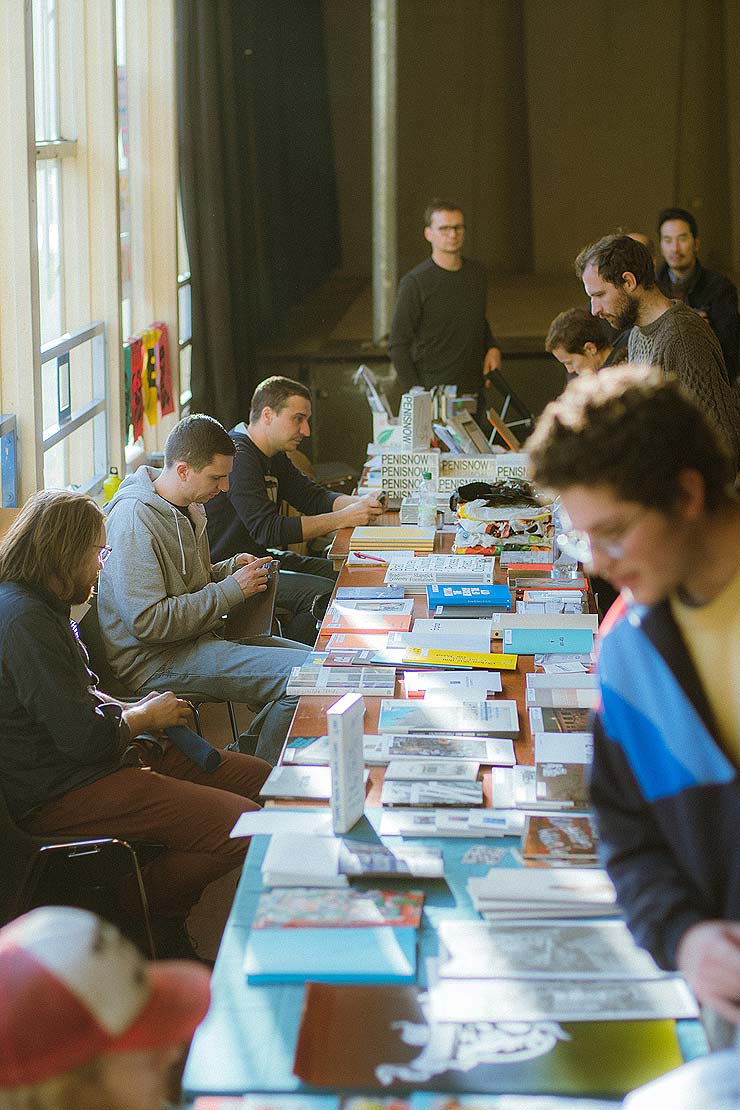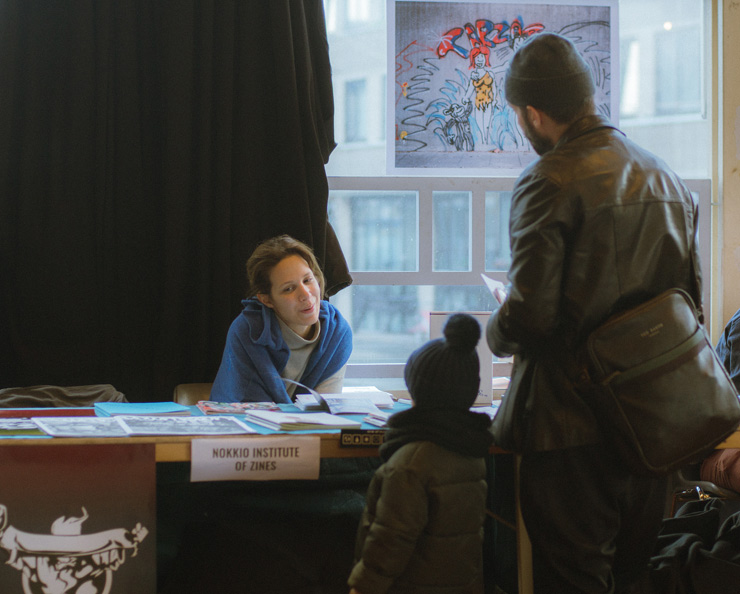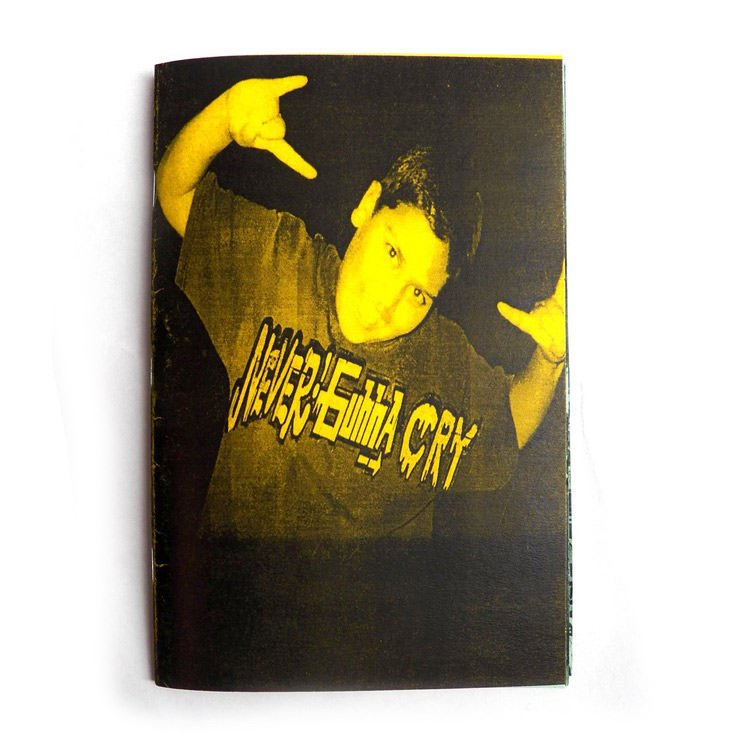Just completed this weekend in Amsterdam, a gathering of authors, readers, publishers, academics, and fans of graffiti and urban art all gathered in Amsterdam for the newest edition of the Unlock International Graffiti Publishing Fair and the TAG Conference.
Here graffiti and street art intersects with the world of publishing, specifically with books and zines and related obscure and/or scholarly publications known to relatively few. The list of publishers participating in this genre has steadily grown in the last few years to about 50 here; heavily Eurocentric at this point from countries like Netherlands, Russia, Germany, France, Australia, Japan, Czech Republic, the US and others.

Unlock Book Fair. Amsterdam 2018. (photo © Max van Boxel)
Previously hosted in Barcelona and Berlin, Unlock is coalescing around a growing interest in defining these movements from historical, artistic, and anthropological vantage points; documenting and even codifying an unruly canon of expression through discovery, sharing information, and teaching one another. Toward that end it also hosts talks, panels, and screenings – this weekend included speakers like Jens Besser, Suse Hansen, Hugo Kaagman, Carlo McCormick, and Diana Ozon,
Among the self-publishing authors represented at the fair this year are Adam Void and Chelsea Ragan, who have been operating a Graff Zine distribution / publishing house called Cut In The Fence. Mr. Void share’s with us today images of his new work, straight from the D.I.Y. / punk / cargo jumping scene that is always inter-marbled with graffiti and autonomous art making in the US, where he operates. Today we’re pleased to present a great interview with Mr. Void and Javier Abarca, the founder of Unlock, and who also is an artist, researcher, and educator.

TAG. Amsterdam 2018. (photo © Ka-Tjun Hau)
Interview with Javier Abarca by Adam Void:
Adam Void: Javier, in your 12+ years as a researcher and educator of graffiti and street art, what brought you to founding the Unlock Book Fair & the Tag Conference?
Javier Abarca: There is a whole scene of independent publishers working with graffiti and related fields an there was no meeting space for it. The idea immediately caught on, which showed there was a need for it. We also use the fair platform to advance the research on neglected but fascinating topics within the field. Last year we focused on hobo graffiti, this year we are delving into punk graffiti. We gather and display rare books on the subject, program talks and screenings about it and publish a companion book with obscure documentation.

TAG. Amsterdam 2018. (photo © Robin Vermeulen)
Adam Void: How do you see the Unlock Book Fair differing from other zine fairs or celebrations of graffiti & street art?
Javier Abarca: Unlock is much like other book fairs, but it is focused on a particular field. It has little to do with other events related to graffiti and street art, which tend to focus on the production of commissioned artworks. Our job is independent research and documentation of furtive public art, mostly in the form of books and zines, but also screenings, talks, performances, etc.
Adam Void: This year’s showcase is focused on “Punk & Graffiti”, what are the core connected elements between these two cultures?
Javier Abarca: The core thread connecting punk and graffiti is of course the DIY ethics. Today graffiti has turned, to a great extent, into an act of consumption, but it used to be all about do-it-yourself. DIY is the defining quality of punk, of graffiti and of many other independent cultures.

Adam Void: Can you expand on this some? How do punk and traditional graffiti cultures exhibit the Do-It-Yourself ethos? What is the change you have seen in graffiti as of recent times?
Javier Abarca: Punk’s approach to creating music and graphic communication is of course quintessential DIY. And graffiti used to be that as well, kids had to find ways to hack the elements on hand –spraycans, markers, inks, the subway system– to create a fantastically visible city-wide graphic communications game starting from zero resources.
It is the specialized media –fanzines, then the internet– and the specialized market –with custom-made tools and materials of every kind– which have largely transformed graffiti from DIY to an act of consumption. People do not need to go out and seek the graffiti throughout the city to get inspired when a whole world of graphic references is just a few clicks away. And there is no more need to hack and customize tools –after learning how to do it from a mentor– when any specialized tool you can imagine is readily available and can be bought online.

TAG. Amsterdam 2018. (photo © Robin Vermeulen)
Adam Void: Most of the publications in the showcase are centered on punk & graffiti history. What do you see as the future for this element of graffiti?
Javier Abarca: Punk graffiti is mostly a thing of the past. The focus of the two “Punk Graffiti Archives” books we have published for the fair are the punk-originated tagging scenes that thrived in Amsterdam and Madrid in the late 70’s and 80’s with barely any knowledge of what was happening in NYC. These are largely ignored cultural treasures. Both cultures disappeared when the NY tradition of graffiti took over European youth through the 80’s. Punks may still write on walls, but graffiti as a culture is dominated globally by the NY tradition.
Adam Void: Unlock has exhibitors from all over Europe (19 countries), as well as Japan & the US. What are the main similarities and differences in the publications exhibited across this wide sampling?
Javier Abarca: Each publication is a unique, fascinating world. But most publishers work from a similarly independent, even DIY position, even if they are based in different continents. This means the possibilities and limitations they face tend to be similar, which can translate into their approaches and results.

Unlock Book Fair. Amsterdam 2018. (photo © Max van Boxel)
Adam Void: Are there other continents, countries, or parts of the world that you would like to get involved with the Unlock Book Fair and the TAG Conference? If so, how should they get in touch for next year?
Javier Abarca: Both the Tag Conference and the Unlock Book Fair are meetups of the international global scenes of graffiti research and graffiti publishing. They could take place anywhere. People can get in touch via email at info@unlockfair.com, or through our Facebook and Instagram accounts @unlockfair and @thetagconference. We are in conversation with people from a number of cities in Europe and America who have expressed their interest in hosting the events.
Adam Void: Will you share an anecdote from the three-year history of the Unlock Book Fair that best exemplifies the spirit of the event?
Javier Abarca: That would be the cantina. A central feature of the fair is the cantina serving complimentary, communal meals to publishers, speakers and staff. It is run by Unlock team member Akim, the Berliner legend of graffiti, street art and underground mischief, whose cooking abilities are well known in the scene. One of the main goals of the yearly Unlock Book Fair is to be a meetup of the publishing scene, and the cantina is its social heart.
Apart from this, the hilarious and fascinating readings and performances by team member Dumar NovYork –the legendary NYC bomber– are probably the moments that best portray the spirit of the Unlock Book Fair: knowledgeable, but just as fun.

Unlock Book Fair. Amsterdam 2018. Carlo McCormick was in da house. (photo © Rebecca Schaefer)
Adam Void: What have you seen at this year’s fair that brings you excitement about the current state of graffiti publishing?
Javier Abarca: The graffiti publishing scene is growing stronger and more interesting. It would be fair to say the Unlock Book Fair is playing a key role in this, in Europe in particular. A number of publishers have mentioned how this yearly meeting has become a motivation to put out more and better work, and how they leave the fair inspired by the contact with so many books and publishers. People are coming from as far as Moscow, Montreal, New York, Sydney, São Paulo or Tokyo to present their books, to talk, or simply to attend the fair and the Tag Conference.
Adam Void: What is next for you in your personal exploration in the dusty corners of graffiti culture?
Javier Abarca: Next year’s Tag Conference will again create space for the the study of barely known forms of name writing. There is a list of obscure topics we want to explore in coming installments of the Unlock Book Fair. And I am working on a new groundbreaking international project that will create more opportunities for shedding light on overlooked topics which deserve more exposure among specialized audiences. Stay tuned!

Unlock Book Fair. Amsterdam 2018. (photo © Max van Boxel)

Unlock Book Fair. Amsterdam 2018. (photo © Max van Boxel)

Unlock Book Fair. Amsterdam 2018. (photo © Max van Boxel)

Unlock Book Fair. Amsterdam 2018. (photo © Max van Boxel)

Unlock Book Fair. Amsterdam 2018. (photo © Max van Boxel)

Unlock Book Fair. Amsterdam 2018. (photo © Max van Boxel)

Unlock Book Fair. Amsterdam 2018. (photo © Max van Boxel)

Cut In The Fence. Adam Void’s Misadventures and Musings. Train Brain. Unlock Book Fair. Amsterdam 2018. (photo © Adam Void)

Cut In The Fence. Adam Void’s Misadventures and Musings. Train Brain. Unlock Book Fair. Amsterdam 2018. (photo © Adam Void)

Cut In The Fence. Adam Void’s Misadventures and Musings. Raider Pack. Unlock Book Fair. Amsterdam 2018. (photo © Adam Void)

Cut In The Fence. Adam Void’s Misadventures and Musings. Raider Pack. Unlock Book Fair. Amsterdam 2018. (photo © Adam Void)
Cut In The Fence. Fishglue & MTN NGC. Unlock Book Fair. Amsterdam 2018. (photo © Adam Void)

Cut In The Fence. Fishglue & MTN NGC. Unlock Book Fair. Amsterdam 2018. (photo © Adam Void)

Cut In The Fence. Fishglue & MTN NGC. Unlock Book Fair. Amsterdam 2018. (photo © Adam Void)
Other Articles You May Like from BSA:
Developing a library of personal alphabets, coded symbols, muscle memory and intended meanings. New York street artist Modomatic is finding his way among a crowded field of new additions to the co...
Here in New York everybody is still out kickin around the streets because the weather is warm and to welcome the oceanic flood of tourists who are here to see the big parade, the Rockettes, The Boo...
This week BSA is in Borås, a municipality in south-western Sweden for the 3rd edition of No Limit, a mural arts festival that brings Street Artists from around the world to create new works on wal...
“The artwork invites us to think about the lack of empathy we demonstrate towards the rest of the species and to the action/reaction process that ensues”, says street artist and muralist Gola Hundun...
It may be a challenge to identify the through-line when it comes to curation of artworks at an auction house exhibition. Selections are predicated on the availability of artworks at the moment and th...
 BROOKLYN STREET ART LOVES YOU MORE EVERY DAY
BROOKLYN STREET ART LOVES YOU MORE EVERY DAY










